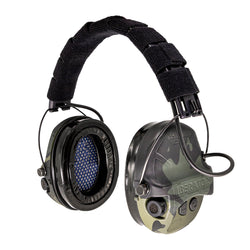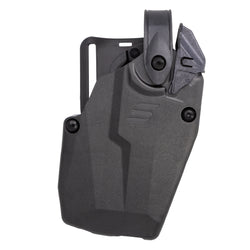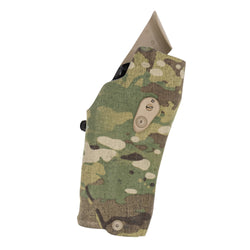Holster setups are as varied as holsters and firearms themselves. We all have our favorite way to set our carry holsters or duty holsters. Setups depend on gear, gun, carry profile, personal preference, or any combination thereof.
In a recent Achilles Heel Tactical video, Paul Costa from Achilles Heel Tactical shows us how he sets up his duty and training belts for the classic scoop draw, while adding a Safariland ALS retention mechanism to the mix.

Costa says he likes the scoop draw because it allows a single, fluid motion all the way through the draw stroke. That single motion eliminates the need to stop and reverse direction, allowing the shooter to maintain momentum throughout the presentation. Costa says his tests indicate that maintaining momentum throughout the draw can save up to two-tenths of a second.
“Any time that you have to stop momentum and then regain it to present to the target” is inefficient, he says. “If I don’t have to do that, I’m not willing to give up that time.”

Costa sets up his Safariland holster to maximize that momentum while also accounting for the integral Automatic Locking System (ALS) lever with which the holster is equipped.
Many shooters like a forward cant on their sidearm as it facilitates forward motion toward the presentation on the draw stroke. But a forward cant isn’t compatible with a scoop draw combined with the ALS system since the shooter’s thumb cannot reach the release lever using the proper scoop technique. Reaching for the lever on the scoop requires an awkward hand angle that stops the stroke’s momentum.

A Slick Way to Scoop Draw
But fear not, there’s a setup that allows for uninterrupted momentum while also engaging the ALS lever. Costa sets up his duty and training belts the same way. He uses a Safariland Quick Locking System (QLS) mount, though you can also use a direct mount if you like.
The key is a slight negative cant, which can be done with the QLS fork and the holster itself. Costa combines the two to get what he wants. He is clear that your hand size will determine how much cant will be needed.
The negative cant allows you to drive your thumb to the ALS lever, thus making it your index point. Most shooters index on the gun with their middle finger, and you can still do that. But Costa recommends that you also have your thumb arrive ever so slightly before the rest of your hand so that depressing the lever becomes part of the draw stroke.

This sequence allows the draw’s momentum to continue uninterrupted. It will also require practice to have your thumb in the right place at the right time.
Costa uses the enhanced ALS Nub Mod from OT Defense to provide a larger and more positive interface between the thumb and lever. He points out that enhancing the lever allows you greater access, but he warns that it can potentially enhance an adversary’s access too. But he says that he’s run his duty holster that way for 15 years, and it’s never been a problem. You can decide whether that accessory might work for you.
Regarding his belts and holsters, Costa says, “I set them up in a way that allows me to facilitate a very clean, consistent draw, without losing momentum.” That allows a faster index on the target.

Smooth and Fast
Costa obviously does it well. He demonstrates several draws against a timer after breaking the motion down into its component parts. His best time for draw and a shot on target was 0.71 seconds, though he says he can do better. Watching him do it, the draw stroke is very smooth, and you can see that momentum is indeed maintained throughout.

This is an intriguing draw method. Proper practice will teach you to drive your thumb to the ALS lever and maintain momentum all the way through. I tried it with one of my ALS holsters. I was able to do it, but I need a lot more work to smooth it out. But I liked the draw stroke itself.
I plan to practice it some more and see how it goes. I’ve always canted my two ALS holsters forward or not at all. I never considered the advantages of a slight negative cant to provide quicker access to the ALS lever. Much less to facilitate drawing with momentum.
Watch the video for yourself:









